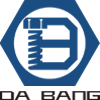Bien que électrozinguéboulonsBien que les boulons en zinc revêtus de couleur semblent similaires en apparence, leurs performances anticorrosion et leurs applications diffèrent sensiblement. L'électrozingage forme une couche de zinc blanc argenté à la surface du boulon par dépôt électrolytique. L'épaisseur est généralement comprise entre 5 et 12 μm et permet de le maintenir exempt de rouille pendant 80 à 120 heures lors du test au brouillard salin. Ce procédé est peu coûteux et permet de traiter des milliers de boulons en un seul lot en quelques heures seulement. La couche de zinc présente une bonne conductivité et convient aux structures nécessitant une conduction de courant, comme les boulons de mise à la terre des armoires électriques ou les connecteurs de batteries de nouvelle génération.
Les boulons en zinc coloré sont passivés au chromate par électrozingage, formant ainsi une couche d'oxyde multicolore à leur surface. Cette couche de 0,3 à 0,8 μm augmente la résistance au brouillard salin à 200-300 heures et confère aux boulons un aspect plus distinctif. Par exemple, le zingage coloré des boulons de châssis automobiles permet de prolonger leur durée de vie de 2 à 4 ans dans les environnements très humides des zones côtières. La surface dorée facilite l'identification rapide des spécifications et des modèles lors de l'assemblage. Cependant, la couche de passivation réduit la conductivité d'environ 25 % ; elle est donc déconseillée pour les connexions de circuits de précision.
En termes de coût, le coût de traitement du zingage est de 15 à 20 % supérieur à celui d'un placage électrolytique classique en raison des multiples procédés de passivation. Cependant, pour les structures exposées à l'extérieur pendant une longue période, comme les boulons des antennes-relais 5G, le zingage est plus économique : son cycle de maintenance est prolongé de 18 à 36 mois et son coût total de vie est réduit de plus de 30 %. Les principaux paramètres des deux procédés sont comparés comme suit :
Les facteurs environnementaux stimulent également l'amélioration des procédés. La solution contenant du chrome utilisée pour le zingage traditionnel est remplacée par des alternatives plus sûres. Bien que le nouveau procédé offre un temps de protection contre la rouille légèrement plus court, il simplifie le traitement des eaux usées et est plus conforme aux normes environnementales internationales. De plus en plus de boulons d'équipements électromécaniques exportés vers l'Europe utilisent désormais un zingage sans chrome.
En usage quotidien, les boulons en zinc électrolytique conviennent aux environnements secs tels que les meubles et les machines d'intérieur. Les boulons zingués, quant à eux, sont principalement utilisés dans des environnements exposés au vent et à la pluie, comme les châssis automobiles et les charpentes métalliques de ponts. Lors de l'installation, il est important de noter que la surface des boulons zingués est plus lisse et qu'une force de serrage trop importante peut facilement endommager la couche protectrice. Il est généralement recommandé d'utiliser une force inférieure de 5 à 8 % à celle d'un placage électrolytique classique. Une nouvelle technologie de revêtement permet désormais de rendre les boulons zingués plus résistants à la rouille et est même utilisée dans la fabrication d'instruments de précision.
Date de publication : 16 avril 2025
